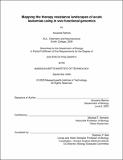Mapping the therapy resistance landscapes of acute leukemias using in vivo functional genomics
Author(s)
Ramos, Azucena.
Download1227031751-MIT.pdf (35.63Mb)
Other Contributors
Massachusetts Institute of Technology. Department of Biology.
Advisor
Michael T. Hemann.
Terms of use
Metadata
Show full item recordAbstract
The recurrence of therapy resistant disease remains an intractable problem in oncology clinical care. To address this issue, investigators have traditionally focused on elucidating cell-intrinsic mechanisms that render tumors refractory to both classical chemotherapeutics and targeted agents. However, cancers resident in organs throughout the body do not develop in isolation. Instead, tumors arise in the context of the non-malignant components of a tissue, defined as the tumor microenvironement (TME). While the importance of cell-extrinsic factors in cancer biology is well established, our understanding of the TME's influence on therapeutic outcome is in its infancy. Pooled in vivo screens offer an unbiased strategy for identifying novel resistance mediators in the context of a normal immune system and microenvironment. In the first part of this thesis, I describe the results of an in vivo RNAi screen in a treatment naïve mouse model of acute myeloid leukemia (AML) completed in the context of combination chemotherapy. Using this approach and a new mouse model of AML chemoresistance generated in our lab, I identified and validated the tricarboxylic acid cycle gene Succinate-CoA Ligase GDP-Forming Beta Subunit (SUCLG2) as an in vivo-specific mediator of therapy resistance. Additional experiments indicate that proper function of the Succinate-CoA Synthetase (SCS) complex, in which SUCLG2 functions, is critical for AML LSCs to survive therapy. Our data suggest that depletion of SCS members may lead to altered tumor energetic features that ultimately sensitize AML blasts to combination chemotherapy. In the second part of my thesis, I describe a genome-wide CRISPR-Cas9 screen to investigate mechanisms of resistance to chimeric antigen receptor T cell therapy in a mouse model of B-cell acute lymphoblastic leukemia both in vitro and in vivo. Here, we describe preliminary results from an in vivo pilot screen and results from in vitro genome-wide screens. Preliminary analyses indicate the screen is robust, with genes previously reported to be important for T cell mediated killing showing expected phenotypes. Ultimately, completion of these screens will provide the field with a critically necessary data set that can guide efforts to uncover highly synergistic agents that potentiate the effects of this promising treatment modality.
Description
Thesis: Ph. D., Massachusetts Institute of Technology, Department of Biology, 2020 Cataloged from student-submitted PDF of thesis. Vita. Includes bibliographical references.
Date issued
2020Department
Massachusetts Institute of Technology. Department of BiologyPublisher
Massachusetts Institute of Technology
Keywords
Biology.